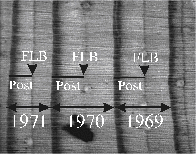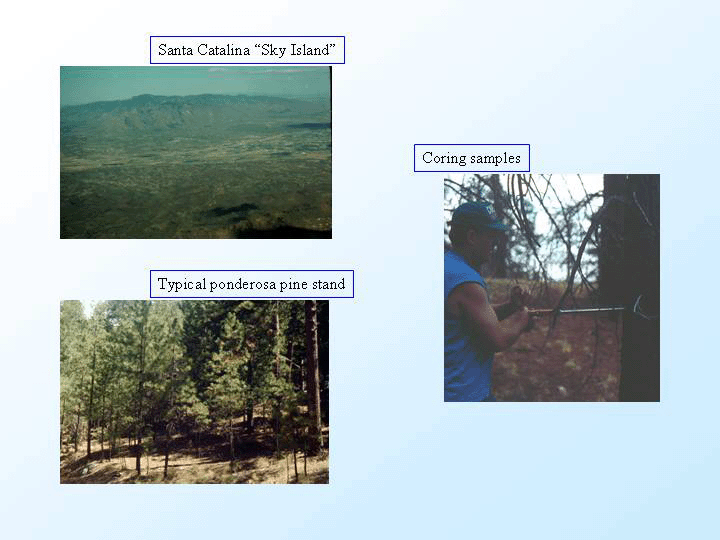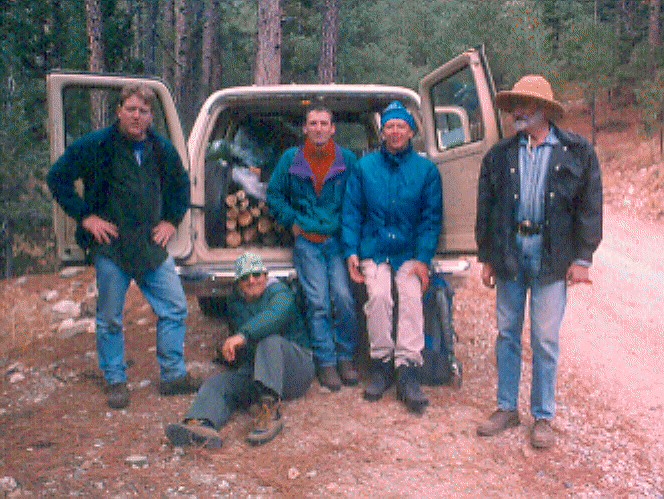Tree-Ring Formation, Isotopes, and
El Niņo
in Ponderosa Pine of the Southwest
(NSF
GRANT #(NSG-ESH-)ATM-9810474 1 Oct. 1998 to 30 Sept. 2002)
Principal Investigators:
Steven W. Leavitt, Austin Long, Harold C. Fritts, Wm. Edward Wright, and Deborah
Hemming (Post-Doc)
The southwestern United States is an
important climatic transition region between "genetic climate
regions" (Bryson and Hare, 1974), whose boundary varies seasonally and
from year to year. Important meteorological phenomena contributing to the
inter-annual climatic variability in this region include El Niņo/La Niņa
events, which are particularly influential in winter precipitation, and the
more erratic summer influence of the western limb of the North American
monsoon system. Prospects for reconstructing long-term incidence, extent and
strength of these climate events can be improved by using proxy tools such as
tree rings, on which a wide variety of parameters may be measured, such as
ring width, wood x-ray density, cell size, and isotopic composition.
We have used stable isotope analysis of tree
rings in the Southwest in this and the preceding grant to derive empirical
relationships between the isotopic composition of ponderosa pine wood
cellulose and environmental parameters such as drought, precipitation amount,
humidity and sea-surface temperature. These relationships were developed for
stable oxygen and carbon isotopes on a largely spatial scale involving a
network of sites whose rings were analyzed for an 11-y period, and on a
temporal scale at one site where a 100-y chronology was developed.
Furthermore, seasonal relationships were explored by subdividing the rings
into 3 subdivisions (Fig. 1) anchored on the inside and outside of the ring
and a false-latewood band occurring within the growth band and signifying the
onset of the monsoon season (about the first week in July).

Fig. 1. Subdivisions of rings based on false-latewood band (FLB).
Post-false segment is indicated, and there are 2 equal pre-false subdivisions
("Pre-1" and "Pre-2")


Additionally, we improved the mechanistic TREERING 3
growth model and employed it to advance our understanding of processes and
mechanisms by which tree rings acquire an isotopic composition related to
these environmental signals. The basic model takes the raw materials of
photosynthesis (carbon dioxide and water) together with climatic inputs
(sunlight, soil water, and sensible heat) to manufacture photosynthates and
then sequentially initiate and mature wood cells with those photosynthates.
By adding isotopic subroutines according to the current theoretical models of
isotope incorporation in plants, changes in climate or isotopic composition
of CO2 and water during the growing season were then be incorporated into the
isotopic composition of both individual cells as they develop over some
finite period and the sequence of cells formed during the growing season.
Implementation of the isotope subroutines was guided (calibrated and
verified) with seasonal tree-ring isotope data and with precise
plant-growth-isotope data derived from field experimentation. We were
particularly interested in how the process model might guide our
understanding of the interaction of multiple factors producing the
distribution of isotopes measured within tree rings and ultimately better
reconstruction of environment from isotopic measurements.
The project contributes to the focus of SWLs research
on stable isotopes in tree rings, leaves and soils as tracers and indicators
of the environment in modern, historical and prehistorical contexts.
Specifically, the research has 1) developed seasonal isotope (d13C [link to Data],d18O) chronologies of ponderosa pine
(and related Apache pine) from about 1985-1995 in 7 mountain ranges in S.
Arizona and New Mexico, with subsampling of periods formed before and after
the onset of the summer monsoon, 2) developed a 100-yr seasonal isotope (d13C, d18O)
chronology from ponderosa pine a site in the Santa Catalina Mts. near Tucson,
3) monitored environment and collected precipitation, soil water and plant
water at the Santa Catalina site to better understand the mechanisms
contribution to d18O in the tree rings, 4) conducted
double-labeling isotope tracer (d13C, d18O) experiments in the Santa
Catalina Mts. to better understand the timing of incorporation of isotopes
generated during photosynthesis into the tree rings themselves, 5) collected
needles samples at biweekly intervals during the 1998 and 1999 growing
seasons to better link d13C and d18O in
the needles to those in the rings, 6) added mechanistic algorithms for dD,
d13C, d18O into the tree-ring growth model
TREERING 3.0 for the purpose of modeling of cell-by-cell development and
isotopic composition as related to primary input variable of temperature,
precipitation and sunlight. This data is being linked together through the
model to properly represent processes producing the isotopic compositions we
are measuring in seasonal segments of ponderosa pine rings.
Publications and Presentations:
Hemming, D.L., H.C. Fritts, S.W. Leavitt, W.E. Wright, A. Long. (1999)
Modelling tree ring d13C. American Geophysical Union.
Abstracts - San Francisco,
December 1999.
Hemming, D.L., Fritts, H.C., Leavitt, S.W., Wright, W.E., Long, A., Shashkin,
A. (2000) Incorporating stable isotopes into the 'TreeRing 2000' model of
tree ring formation. International Conference on Dendrochronology. Abstracts
- Mendoza,
March 2000.
Hemming, D., Fritts, H.C., Leavitt, S.W., Wright, W., Long, A., Shashkin, A.,
2001. Modelling tree-ring d13C. Dendrochronologia 19(1): 23-38.
Hemming, D., Fritts, H., Leavitt, S., Wright, W., Shashkin, Long, A., 2001. A
process model of tree-ring d13C, d18O and dD applied to 20th
Century ponderosa pine growth in southern Arizona. 18th Pacific Climate Workshop,
Asilomar Conference Center, Pacific Grove, CA, 18-21 March (abstr).
Hemming, D., Jalkanen, R. and Leavitt, S.W., 2001. Preliminary relationships
between climate and the apical extension, needle production and ring width of
Pinus ponderosa in Arizona, USA. The
Palaeobotanist 50(1): 125-131.
Leavitt, S.W., 2002. Moisture availability and water-use efficiency in d13C of pine tree
rings of the U.S. Southwest. 6th International Conference on
Dendrochronology, Quebec City,
Canada, 22-27
August.
Leavitt, S.W. and Baisan, C.H., 2001. Variability of seasonal d13C patterns in
Apache pine from southern Arizona, USA,
The Palaeobotanist 50(1):
117-123.
Leavitt, S.W., Wright,W.E., Hemming, D., Long, A., 2002. Micro-variation of d13C in tree rings
of ponderosa pine from S. Arizona.
Ecological Society of America
Annual Meeting, 4-9 August, Tucson.
Leavitt, S.W., Wright, W.E. and Long, A., 1998. ENSO signal in d13C of pre- and
post-false latewood of ponderosa pine tree rings in southeastern Arizona. Proceedings
of the 14th Pacific Climate (PACLIM) Workshop, 6-9 April 1997, Two Harbors,
Santa Catalina Island. Eds. Wilson, R. and
Tharp, V., Technical Report #57 of the Interagency Ecological Program for the
Sacramento-San Francisco Estuary, pp. 61-68, April 1998.
Leavitt, S.W., Wright, W.E. and Long, A., 1999. Evidence for ENSO in
Tree-Ring d13C Along a 500-km E-W Transect in Southern
Arizona and New Mexico.
Proceedings of the 15th Pacific Climate (PACLIM) Workshop, 27-30 April 1998, Two Harbors,
Santa Catalina Island. Eds. Wilson, R. and
Buffaloe, L.D., Technical Report #64 of the Interagency Ecological Program
for the Sacramento-San Francisco Estuary, pp. 61-68.
Leavitt, S.W., Wright, W.E., Long, A. (2000) Seasonal d13C variability
in ponderosa pine tree rings in southern Arizona and New Mexico.
International Conference on Dendrochronology. Abstracts - Mendoza, March 2000 (abstr.).
Leavitt, S.W., Wright, W.E. and Long, A., 2000. Seasonal water status in
carbon-13/carbon-12 ratios of ponderosa pine tree rings from S. Arizona and New Mexico. AGU Fall
Meeting, 15-19 December 2000, San
Francisco, CA. (Eos, Transactions of the American
Geophysical Union, v. 80, n. 48, p. F460 (abstr.)).
Leavitt, S.W., Wright, W.E. and Long, A., 2001. Stable isotopes, tree rings
and the southwestern Monsoon. 18th Pacific Climate Workshop, Asilomar
Conference Center, Pacific Grove, CA, 18-21 March (abstr.).
Leavitt, S.W., Wright, W.E., Long, A. 2002. Spatial expression of ENSO,
drought and summer monsoon in seasonal d13C of ponderosa pine tree rings in
southern Arizona and New Mexico. Journal of Geophysical
Research 107(D18) 4349,
doi:10.1029/2001JD001312. (Link to Data)
Leavitt, S.W., Wright, W.E., Long, A. and Fritts, H., 2001. A century-length
tree-ring d13C chronology from southeastern Arizona. Proceedings of 17th Annual
Pacific Climate (PACLIM) Workshop, 22-25 May 2000, Two
Harbors, Santa
Catalina Island. Eds. West, G.J. and Buffaloe, L.D., Technical
Report #67 of the Interagency Ecological Program for the San Francisco
Estuary, pp. 11-18, March 2001.
Wright, W.E. 2001. D and 18O in Mixed Conifer Systems in the United States
Southwest: The Potential of d18O in Pinus ponderosa tree rings as a natural environmental recorder.
Ph.D. Dissertation, University of Arizona, Tucson,
AZ. 329 pp.
Wright, W.E., Long, A., Comrie, A., Leavitt, S., Cavazos, T. (1999) The North
American Monsoon: Eastern Pacific Atmospheric Circulation, Sea Surface
Temperatures and 18O in Terrestrial Precipitation. American Geophysical Union. Abstracts - San Francisco, December 1999 (abstr.).
Wright, W.E., Leavitt, S.W., 2001. The potential of tree-ring 18O as a proxy
for mean northward moisture transport during and immediately following the
North American Monsoon. NOAA 26th Annual Climate Diagnostics and Prediction
Workshop, Scripps Institution of Oceanography, La Jolla, California,
22-26 October.
Wright,W.E., Leavitt, S.W., 2002. d18O Variation in Pinus ponderosa
needle subdivisions from two growing seasons. Ecological Society of America Annual Meeting, 4-9 August, Tucson.
Wright,W.E., Leavitt, S.W. 2002. Specific humidity reconstruction in the
semi-arid southwestern United
States using cellulose oxygen isotope
ratios. 6th International Conference on Dendrochronology, Quebec City, Canada,
22-27 August.
Wright, W.E. and Leavitt, S.W. 2006, Needle cell elongation and maturation
timing derived from pine needle cellulose d18O. Plant, Cell and Environment 29: 1-15.
Wright, W.E. and Leavitt, S.W. 2006.
Seasonal humidity reconstructed from a tree-cellulose d18O time series. Journal of Geophysical Research 111: D18105, doi:10.1029/2005JD006806.
Wright, W.E., Leavitt, S.W. and Long, A., 1997. Intra-annual measurements
of d18O compared with d13C in tree cellulose: A unique record
reflecting either physiological responses or challenging fundamental
assumptions. 7th Annual V.M. Goldschmidt Conference, 2-6 June, Tucson. LPI
Contribution No. 921, Lunar and Planetary Institute, Houston, pp. 221-222.
Wright, W.E., Leavitt, S.W., Long, A. 1999. ENSO Teleconnections: Eastern
Pacific Sea Surface Temperature Correlations with d18O in
Southeastern Arizona Precipitation and Tree Cellulose. Proceedings of the
15th Pacific Climate (PACLIM) Workshop, 27-30 April 1998, Two Harbors,
Santa Catalina Island. Eds. Wilson, R. and
Buffaloe, L.D., Technical Report #64 of the Interagency Ecological Program
for the Sacramento-San Francisco Estuary, pp. 97-109, April 1999.
Wright, W., Leavitt, S., Long, A., Comrie, A., Cavazos, T., Eastoe, C.
(2000) Can Stable Isotopes in Precipitation and Post-false Latewood Tree Ring
Cellulose Indicate Inter-annual Changes in North American Monsoonal
Circulation? International Conference on Dendrochronology. Abstracts - Mendoza, March 2000
(abstr.).
Wright, W.E., Long, A., Comrie, A.C., Leavitt, S.W., Cavazos, T., Eastoe, C.
2001. North American Monsoonal Moisture Sources and Climatic Teleconnections
Revealed Using Precipitation Stable Isotope Timeseries. 12th Symposium on
Global Change Studies and Climate Variations, Session 9: North American
Monsoon. 13-18 January, Albuquerque,
NM.
Wright, W.E., Long, A., Comrie, A.C., Leavitt, S.W., Cavazos, T., Eastoe, C.
2001. Monsoonal Moisture Sources Revealed Using Temperature, Precipitation,
and Precipitation Stable Isotope Timeseries. Geophysical Research Letters
28(5): 787-790.
|